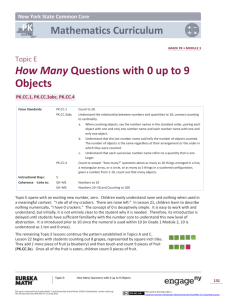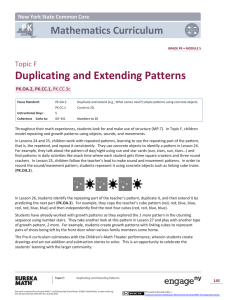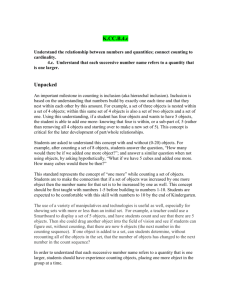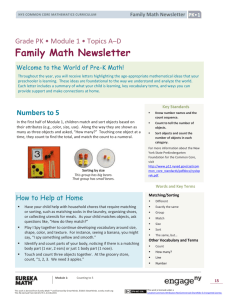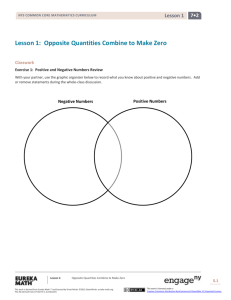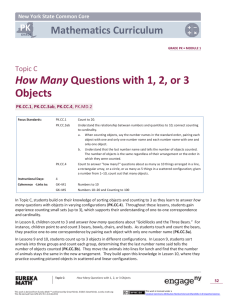Prekindergarten Mathematics Module 1, Topic G
advertisement
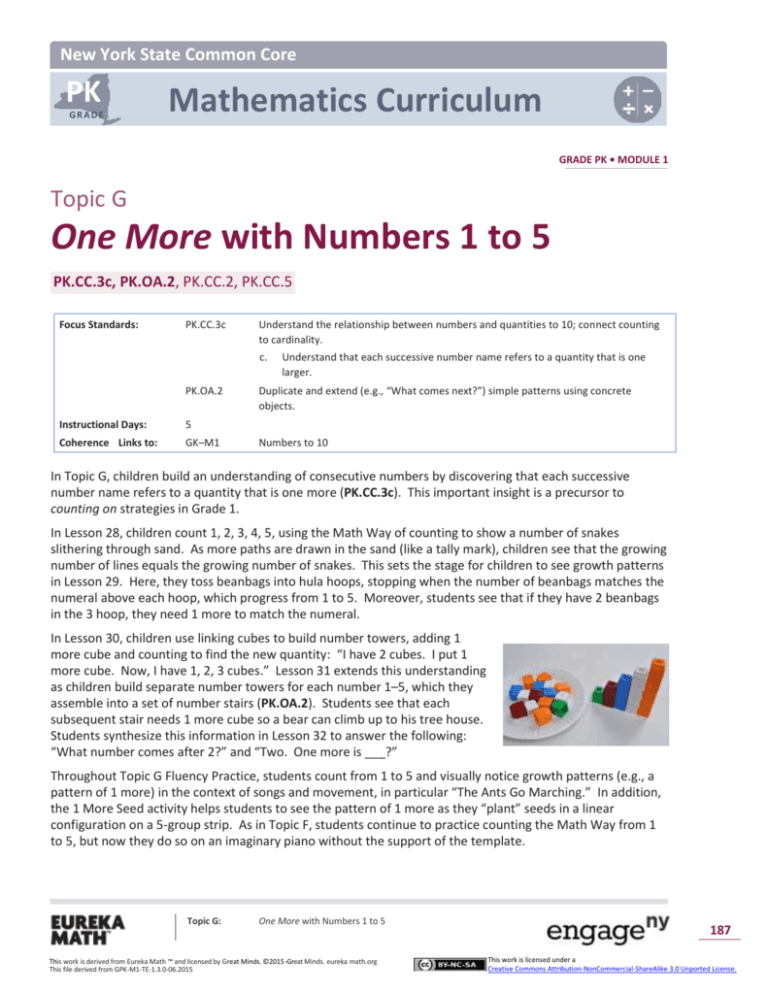
New York State Common Core PK GRADE Mathematics Curriculum GRADE PK • MODULE 1 Topic G One More with Numbers 1 to 5 PK.CC.3c, PK.OA.2, PK.CC.2, PK.CC.5 Focus Standards: PK.CC.3c Understand the relationship between numbers and quantities to 10; connect counting to cardinality. c. PK.OA.2 Instructional Days: 5 Coherence Links to: GK–M1 Understand that each successive number name refers to a quantity that is one larger. Duplicate and extend (e.g., “What comes next?”) simple patterns using concrete objects. Numbers to 10 In Topic G, children build an understanding of consecutive numbers by discovering that each successive number name refers to a quantity that is one more (PK.CC.3c). This important insight is a precursor to counting on strategies in Grade 1. In Lesson 28, children count 1, 2, 3, 4, 5, using the Math Way of counting to show a number of snakes slithering through sand. As more paths are drawn in the sand (like a tally mark), children see that the growing number of lines equals the growing number of snakes. This sets the stage for children to see growth patterns in Lesson 29. Here, they toss beanbags into hula hoops, stopping when the number of beanbags matches the numeral above each hoop, which progress from 1 to 5. Moreover, students see that if they have 2 beanbags in the 3 hoop, they need 1 more to match the numeral. In Lesson 30, children use linking cubes to build number towers, adding 1 more cube and counting to find the new quantity: “I have 2 cubes. I put 1 more cube. Now, I have 1, 2, 3 cubes.” Lesson 31 extends this understanding as children build separate number towers for each number 1–5, which they assemble into a set of number stairs (PK.OA.2). Students see that each subsequent stair needs 1 more cube so a bear can climb up to his tree house. Students synthesize this information in Lesson 32 to answer the following: “What number comes after 2?” and “Two. One more is ___?” Throughout Topic G Fluency Practice, students count from 1 to 5 and visually notice growth patterns (e.g., a pattern of 1 more) in the context of songs and movement, in particular “The Ants Go Marching.” In addition, the 1 More Seed activity helps students to see the pattern of 1 more as they “plant” seeds in a linear configuration on a 5-group strip. As in Topic F, students continue to practice counting the Math Way from 1 to 5, but now they do so on an imaginary piano without the support of the template. Topic G: One More with Numbers 1 to 5 This work is derived from Eureka Math ™ and licensed by Great Minds. ©2015 -Great Minds. eureka math.org This file derived from GPK-M1-TE-1.3.0-06.2015 187 This work is licensed under a Creative Commons Attribution-NonCommercial-ShareAlike 3.0 Unported License. NYS COMMON CORE MATHEMATICS CURRICULUM Topic G PK A Teaching Sequence Toward Mastery of One More with Numbers 1 to 5 Objective 1: Count 1, 2, 3, 4, 5 with stories. (Lesson 28) Objective 2: Find 1 more. (Lesson 29) Objective 3: Build a tower by putting 1 more cube or block at a time. (Lesson 30) Objective 4: Build number stairs showing 1 more with cubes. (Lesson 31) Objective 5: Count up—What comes after? (Lesson 32) Topic G: One More with Numbers 1 to 5 This work is derived from Eureka Math ™ and licensed by Great Minds. ©2015 -Great Minds. eureka math.org This file derived from GPK-M1-TE-1.3.0-06.2015 188 This work is licensed under a Creative Commons Attribution-NonCommercial-ShareAlike 3.0 Unported License.


